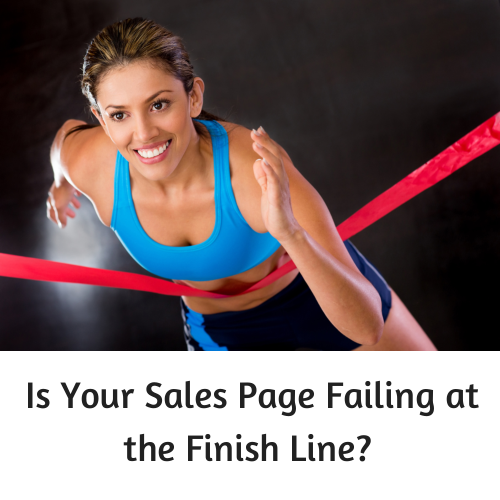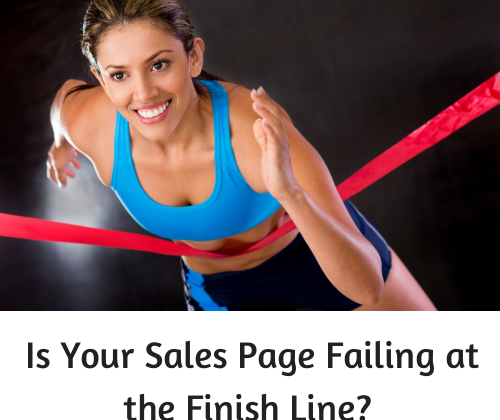 This is part of a free online tutorial on writing sales pages.
This is part of a free online tutorial on writing sales pages.
You’re running the final mile of a marathon.
You stayed the course, pushed through the wall and feel the exhilaration building.
Close to the finishing line, it’s everything you’ve been waiting for: to reach the end, get your medal and free banana and celebrate.
Turning the final corner, you slow down… and stop.
Only you haven’t crossed the finishing line because you can’t see it. The path is no longer marked clearly, but filled with casual crowds milling around.
The vision of your banana and medal fades…
You have to give your reader a clear finish line
Imagine your customer reading your sales page. You’ve got their attention with the headline, hooked them with your opening, laid benefit upon benefit and persuaded and compelled them to keep reading as your offer unfolds.
This is no mean feat, but it doesn’t mean that you’re home and dry.
If your call-to-action lets you down and they walk away, you lose a sale you might never get back.
The call-to-action is the finishing line on your sale page. It clearly marks the point where your customer can celebrate and enjoy your product. Unfortunately, there are a few common mistakes that make your call-to-action blur into the crowd rather than stand out.
To avoid this happening to you, simply follow the following 5 steps.
1. Make it pop out
Like our runner in the crowd, don’t make your call-to-action hard to find. Use contrasting colours for your order button, and make sure it’s easily visible to the reader.
You may even choose to have a call-to-action link or button at the top of your sales page for those readers who have been to your sales page before and are returning to make the purchase. You can even include something simple in the opening of your sales page saying:
Already know you want [product]? Click here to order.
This is effective in a couple of ways:
- For someone who is already pretty keen, it makes it easier for them to buy.
- For someone new to the page, it shows confidence and social proof. You’re basically telling them that others have already been looking at your product and there will be some who want to go straight to the sale.
Whatever you do, don’t bury your order button or links within the text, or with tiny, hard-to-see images. Make it clear where they need to go!
2. Tell them WHY
Remember when we looked at mentioning the price in your sales page we stacked the value so your reader could see what a bargain they were getting? Well with your call to action you want to do something similar by reminding them why they want to cross that finishing line.
Experts in goal-setting and motivation will tell you about the power of visualising the point of reward, rather than the steps needed to get there. When our runner visualises the elation of crossing the finishing line, and the pride of completing the race, they’re spurred on.
It’s the same for your prospect. You want them to visualise the benefits of receiving your product, celebrex the benefits of getting over the finishing line.
Think about the last big thing you bought. If it was a car, you probably weren’t thinking about the paperwork needed to complete the sale. Instead you’re picturing yourself driving it and experiencing the freedom and comfort that first attracted you to the purchase.
So in your sale page, remind your reader why they need to be excited about buying from you. For example:
To experience the bliss and indulgence of an all-inclusive romantic getaway…
To find the freedom and adventure of turning your passion into a viable business…
You’re just 1 click away from the simple plan to help you create delicious, healthy meals for your family on a shoestring budget
Pick one of your leading benefits or the most impressive results of your product and help your reader visualise it before you ask for the sale.
3. Tell them WHAT
You’ve made your order button stand out, you’ve reminded the reader why they want what you have.
Make sure your instructions about HOW they buy are simple and explicit.
This is not about dumbing down your offer, or treating your customer as an idiot. It’s out of respect for their time and attention. They’re busy so don’t make them have to think about the mechanics of buying from you any more than they have to.
Remember, we want them to focus on the point past the sale, rather than the actual sale itself.
Don’t complicate the process with complex buying arrangements, payment plans or too many different options. Make what you have clean and clear.
- If they have to call to make the sale, list the number again.
- If they have to visit a store, provide the address and a map
- If they’re buying online make the payment choice, options and pricing easy-to-understand
4. Tell them WHY NOW
Urgency is a key copywriting tool. It’s not that we want to pressure our reader into buying, it’s just that a deadline works very well to sharpen the decision-making focus. Anyone who has launched a product over a specific time period knows that most sales are made on day one, and the final day, with some coming in right up to the deadline of the offer.
Think about the way you work. You probably have a list of things that you need to look at ‘sometime’ and a list of things that you have to do right now because there’s a deadline to go with the task.
What you need to do with your call-to-action is create a deadline for your customer. This can be done in several ways:
Scarcity:
“The first 100 buyers will also receive a coupon for a free critique of their copywriting”
Deadlines:
“This offer is only available until the 3rd of March, 12pm EST”
“The early-bird price, saving you $400 on the ticket price, is only valid until Monday”
Time-to-results
“Order today and we can have your kitchen fitted within 2 weeks”
“Call today and we can arrange a sales representative to be with you tomorrow”
“Start today and in just 14 days your complexion will be ready for any close-up”
5. Tell them WHAT NEXT
An oft-overlooked step in the call-to-action is explaining to the reader what is going to happen next.
I know I’ve likened the sale to a finishing line, but to your customer, it’s really just the beginning of the adventure. You want your reader to have complete confidence in buying from you, and one way to do that is to strip away the mystery of what happens after they buy.
For example:
Once you register you’ll receive an email straight away with details of how to log into your member’s area. Here you’ll find the course laid out and ready to access, as well as direct links to our support team and the forum.
Once you place your order, our dispatch team will email you within 24 hours to arrange a suitable delivery time for you.
After you sign up, you’ll be redirected automatically to a secure page with a link to download your ebook.
Think about what is going to happen in your sales process. Go through it yourself and test it and make sure you can let your customer know clearly what to expect.
If you’ve been following this tutorial from start to finish, you’re nearly there! Just one more article about the P.S and then I’ll be showing you a possible outline you can use for your own sales page. If you’ve only just joined and want to catch up on the sales page tutorial, click here.

[…] your calls-to-action easy to understand and […]